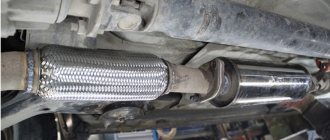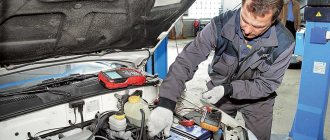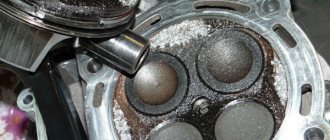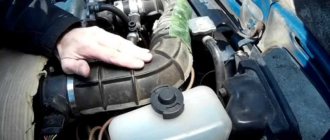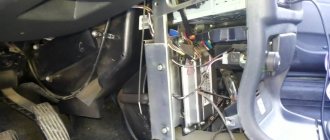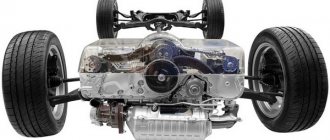Has anyone done a cold intake on a Priora? Is there any sense?
Similar articles
- The other day speed 2 didn't turn on.
- Who recommends which winter studded tires 185/60r14
- It's time to change the thermostat
- Why does the rear one often engage through a grinding noise?
- Warmth and good luck this week
- Have a nice work week everyone
- I went home, it was 730 km one way from point a to point b
- Set a new scene
- Please tell me the mileage on the car is 75500, I think it’s time to change it
- Please advise which heater 220 is better to take on a Priora
- Will the springs settle later?
- I encountered the following problem
- Same problem
- After I turn off the car
- I have this problem
35 comments on “Has anyone done a cold intake on a Priora”
Eat. The pedal reacts more clearly, and at speed you press less on the gas.
Denis, where did the air intake go?
In the radiator grille, just make a hole so that the water can drain, I've been driving like this for two years now, it's no big deal
Doesn't it come from the factory with a cold air intake?
Vasily, from the factory there is a fence on the hood near the left headlight
maybe on Prior 2 there is of course
Denis, tell me also that the speed has dropped
Rishat, what does the speed have to do with it? If all new cars have a cold fence. I have an ancient Prio, I have to modify it myself. Do you know the laws of physics? Will you find the answer in air flows and its volume at certain temperatures?
Denis, maybe you can also say turbocharging
Denis, )) come on, tell me. If the temperature outside is 30 degrees. How does the air duct and your tuned one take it? How many degrees will the difference be there?!
Rishat, take a thermometer and measure it. In addition, when you drive along the highway, air flows from the street and not from under the hood
Rishat, I’ve been sitting here for as long as I’ve been sitting here, and you’re the only one who’s always talking bullshit and arguing. The cleverest? If you don’t want to, don’t ask, the question was about something else. You can also install a carb, it makes no difference
Denis, tell me again it drops to zero)) what is the difference then between the stove and the Conder? Does the stove blow cold in hot weather?! Or the same air and the same temperature?!
Denis, maybe I’m not interested in listening to these fairy tales?
Rishat, don’t listen, no one asked you personally or your opinion
Denis, will there be something on the topic?!
Denis, no offense of course) but the video will be useful) ala story washed + 5 horses
Grigory, you’re dealing with a mouse’s business, the optimal place has already been made from the factory for the intake of cold air, nothing will change if you move it to another place
Grigory, let us in. The car is more responsive in the heat!
Vasily, did you do the entry?
There's already a cold air intake there! if you want to get it done, install the shafts, exhaust and flash it online! But getting the corrugation out somewhere is all a matter of luck!
Gregory, why not do it, are you healthy? they tell you it was made there from the factory and the fence there from the factory is already in the optimal place, they are talking about bullshit
fucking dudes, bullshit, you're bickering, I didn't talk about power and so on, I'm just experimenting, our grandfathers tried to modernize their troughs from a Muscovite to a penny, and the Priora also has enough jambs that can be treated, but at least a little, I personally think that fresh air is never a minus for the engine !
Grigory, there is already fresh air there
Vasily, screw it up, I made it under the grille, it’s become better! So go study physics)
Gregory, and he did the right thing! ))) I also turned off the throttle heating, it also has an effect in the heat.
Grigory, what a dreamer you are)))))))
Vasily, I’m serious, when it warmed up to 95, some kind of dip appeared now, I won’t say that it completely disappeared, but it became more noticeable, better, I’ll try to put it back up for comparison later
Invir, I didn’t know that there was heating, but some kind of tubes suitable for the throttle, as I understand it?
Gregory, yes! There are two pipes on top, unscrew them and connect them together. That is, the hoses are together, the throttle will be cold.
Remove the nameplates from the rear. The car will become lighter. Also + mini pony horse. Physics anyway
Invir, this is probably too much) but tell me, if the antifreeze is not added to the max, can the engine warm up?
Grigory, you shouldn’t do that! Mine always doesn't top up and doesn't heat up. Wash the radiator thoroughly with a Karcher
Installing a cold intake on Lada Granta, Kalina, Priora
Cold Air Intake (CAI) is a system for supplying cold air to the engine intake manifold. Such tuning allows you to slightly increase engine power, reduces the chances of detonation in hot weather, and in some cases it can improve responsiveness to the gas pedal and slightly reduce fuel consumption. Do you know how to make such a modification yourself?
The process of installing a cold intake is shown on Lada Kalina cars. On Lada Granta and Lada Priora, all actions are performed in the same way.
Refinement consists of several stages
:
- Using pipes with a smooth inner surface instead of corrugated pipes.
- Reducing the path to the collector.
- Organizing the intake of cooler air from outside the engine compartment.
Lada 2114
› Logbook › 064: “Cold intake” 80 mm
So, get ready for an epic description of how I made myself a so-called “cold intake” or CW)) I called this system “Super Mega Cool Air Intake Power Up System”))))
Okay, jokes aside. In fact, the reason for this very cold was the recent replacement of the air filter, during which I threw out the air intake pipe. As a result, the engine sucked air right from the middle of the engine compartment, and in the next few hot days I became convinced of its disadvantages)) In a traffic jam, when starting and accelerating, it begins to become terribly dull))
So, at the nearest construction store I bought an aluminum corrugated air duct with a diameter of 80 mm and a length of 1.5 to 3 m, as well as a corresponding clamp. Price: corrugation 140 rubles, clamp 30 rubles.
Then the air filter housing was removed. It was decided to widen the inlet))
I cut it off)) the diameter by eye comes out to be about 75mm.
Since the diameter of the corrugation is a little larger, I wound some double-sided tape that was lying around nearby)) Someone wraps electrical tape, for example.
Then he put on the corrugation and tightened it with a clamp.
I carefully wrapped it with tape just in case so that there would be no air leaks)))) I know that it’s a collective farm)) P.S. Almost immediately I had to tear off all this tape, for the convenience of adjusting the corrugations in the engine compartment))
Then I started to figure out where to put this corrugation and where it would be best to suck the air from))
At first I wanted it like this, in the left turn signal.
But I couldn’t really squeeze the corrugation in there)
Then I decided so. Down to the bumper, there is a small service hole.
But for some reason I didn’t like this idea, and I also didn’t want to get a water hammer in a large puddle, for example))
Then I remembered something, read a little on the Internet. It turns out that this hole for the cold intake was invented a long time ago, even on carb nines, it is located on the right side above the radiator and has an oval shape))
Let's get to it. Remove the plastic protection.
Voila, we see our hole))
I must say that the old nines had such a wonderful device, a small pipe that was inserted into this hole. But, I think you can only find it now at demolition sites, you could do it yourself, but again, at that moment there was no suitable material at hand, at least the same piece of galvanized steel.
First, I made holes to drain excess water.
Then, using a tedious manual method, I pushed the corrugation into this oval hole)) I folded the edges on the outside so that the corrugation would not jump back out)
Then I arranged the corrugation more comfortably in the engine compartment))
I put on the air filter housing, tightened the clamp and again wrapped it with tape)))
Well, that's all)) Like the “cold intake” is ready))
A few photos of the finished HB))
I admit, I was afraid for this corrugation, what temperature it could withstand, I rummaged in the trash and found it))
It’s written up to 250 degrees, but we’ll see during operation))
I haven’t checked it yet in traffic jams and in extreme heat; I haven’t noticed any noticeable improvement, well, maybe a little self-hypnosis)))
Source
Installation
1.
Replace the rubber pipe going from the throttle to the air housing with a steel one. It will not reduce the air flow rate because... the surface inside is smooth (no steps). You can connect the steel pipe to the filter housing using the lower coolant pipe from Kamaz (it’s better to take a silicone one).
2.
We dismantle the standard intake exhaust pipe. Close the standard hole in the filter housing with a hub nut plug from a VAZ 2108. Make a hole with a diameter of 100 mm in the lower part of the air filter housing.
We install one end of the corrugation into the air filter housing (no more than 1 cm), the other under the headlight, so that it faces the air flow. The gap between the air filter housing and the corrugation will serve to discharge water and dirt. We leave the engine air filter as standard.
The process of installing a cold intake is also shown in the video:
System parts and components
The design of the Lada Priora engine cooling device is quite simple and inherent in all injection versions. The coolant circulates in circles - large and small. Let's look at the details of the “cooler” assembly in more detail.
Radiator and electric fan
The radiator and electric fan ensure a constant engine temperature within the range of 87-103 degrees Celsius so that the engine does not overheat. On the first engine models, a three-row cooler of copper construction was installed. But, after unsuccessful tests, the designers decided to change the radiator to a three-row aluminum one.
The electric fan is turned on by a control unit, which regulates the engine temperature using a coolant temperature sensor. Temperature data is read from the cooling jacket and sent to the ECU, which turns the main fan on and off.
A malfunction of the fan and cooling radiator leads to poor circulation and insufficient cooling of the system. In this case, the motor may overheat.
Thermostat
Provides transfer of coolant flows from a small to a large circle and vice versa. So, the thermostat opens at a temperature range of 60-70 degrees. This is one of the most important parts of the engine, since it is what regulates the efficient and rapid warming up of the engine, as well as the normal operation of the coolant system.
When the engine warms up, the thermostat is in the closed position and coolant circulation is ensured in a small circle without the participation of the radiator. After the thermostat opens, the liquid begins to circulate in a large circle, which ensures effective cooling thanks to the radiator.
A malfunction of the thermostat leads to the fact that the engine begins to heat up, since it is in a closed state and often this malfunction is accompanied by frequent activation of the electric fan. Changing the thermostat is easy; to do this, you just need to drain the coolant to a level below the part and unscrew the housing. The product is located under the body.
Water pump
The water pump or pump serves to circulate coolant throughout the system. Failure of this element leads to loss of fluid and overheating of the power unit. Typically, wear on the bearings inside the product will cause it to seize, causing the water pump to start leaking.
Heater
One of the integral elements of the cooling system is the heater system. It includes an inlet and outlet pipe, a radiator and an electric fan. In winter, it is actively used, which further cools the engine.
Expansion tank and plug
Gases and vapors that are formed as a result of the operation of the system are displaced into the expansion tank. There, this element also serves as the coolant level in the system. Air is forced out through the plug, as well as hot “coolant” when the power unit overheats.
Pipes
Pipes are intermediate elements through which coolant circulates and also connect different elements of the system. Failure of these parts can lead to loss of fluid, which can significantly reduce the level in the engine. Typically, depending on the mileage and terrain of operation, it is recommended to change these parts once every 100,000 km.
temperature sensor
The cooling temperature sensor reads temperature data and transmits it to the electronic control unit, which adjusts the temperature. It is installed on the thermostat. A faulty element may cause the motor to overheat because the electric fan will not turn on.
Water jacket
The cooling water jacket is located inside the cylinder block and cylinder head. It ensures the removal of heat from these elements, which heat up during operation. So, with the help of a water pump and pipes, the liquid moves into the radiator, where cooling actually occurs, and then returns to absorb new heat.
Cold intake: pros and cons
Currently, there are many types of car tuning. Modification of the engine part of the car is especially popular among many car owners. Most often, car enthusiasts resort to installing a cold intake, as a result of which cold air begins to flow into the engine. Almost every car owner dreams of his car moving faster and the engine vibrating as little as possible in a traffic jam. However, not everyone knows that modification can be made by installing a cold intake. And not everyone understands what a cold intake is. The pros and cons of the system, as well as installation options for some cars will be discussed in this article.
Priora interior heating system
The vehicle is equipped with a stove (heating system) with a climate control system that provides comfort while traveling in the car. They are designed to eliminate problems in the event of cold weather or other weather changes. No one will ask the question why the stove in the Priora does not work, neither the driver nor the passengers.
The car's climate control system includes:
- the stove itself (heater);
- stove fan device;
- temperature sensor in the cabin;
- air distributor housing;
- airways;
- deflectors (directing the flow of air masses).
The air flow from the stove is transmitted to the housing part of the air distributor, from where it is directed along air lines. Through the air ducts, the flow flows to the windshield grilles of the windshield and side windows, to the air mass flow guides in the center and side of the dashboard, as well as to the lower plane of the cabin to the floor pans on the bottom of the body. With the advent of frost, defects in the heating system appear, the most unpleasant of which is that the Lada Priora stove does not work and other malfunctions.
Disadvantages of cold intake
Among all the disadvantages of installing a cold intake, there are:
- The appearance of strong noise from the zero filter.
- If the system installation technique is not followed, water hammer may occur. Water hammer can also occur due to improper operation of the vehicle.
- The system installation process is quite labor-intensive.
- Change of standard equipment.
- The use of low-quality “zeros” leads to engine damage.
Currently, many tuning studios sell various types of cold intake systems.
Currently, the most common intake systems are:
It is worth remembering that if you do not want to buy expensive ready-made kits and spend money, you can make a cold intake with your own hands.
Increasing power by replacing the intake receiver
The most effective way to add power to the engine is to replace the intake receiver. Reducing the length of the intake mechanism leads to an increase in power. It is almost impossible to carry out this process without the help of specialists. If you decide to carry out such tuning, certain changes should be made to the engine control program. A set of such measures will provide a significant increase in power. The intake system for tuning for VAZ cars is presented in our online store. The catalog contains only high-quality components that allow you to achieve the desired result. Why is it worth ordering tuning components in our store? • Prices are below the average market value; • We provide a guarantee; • We sell only certified spare parts.
Source
Cold intake, Honda
Many Accord car owners are faced with the problem of severe car failures on a hot engine. To fix the problem, most drivers decide to install a cold air intake on their car. For installation, you need to purchase additional gaskets for the manifold. You can also facilitate the flow of cold air by turning off the collector heating. The heating is turned off by sawing off the part of the manifold where the idle air valve was located and where the antifreeze flowed through the channels. Having removed the manifold on the right side of the head, it is necessary to make a thread in the channel in order to eventually install a plug there. After cutting the thread, all chips must be removed. The existing hole in the collector must immediately be sealed with epoxy glue or welded using argon welding. You can saw off the excess part using a grinder. Then we install the parts in their places. In addition, the intake pipe must be routed under the wing. A specially curved tube of the required diameter can be ordered specifically for the Accord. A zero-resistance filter is also installed under the wing instead of the existing resonator.
The heater doesn't heat up at idle
Another problem that car owners face is problems with the kidney idling.
In this case, there are several reasons for the malfunction:
- Low level of antifreeze in the cooling system.
- Leaks that lead to the situation described in paragraph 1.
- Airiness of the system.
The first two problems are rarely difficult to solve. The situation is different when the malfunction is caused by an air lock.
Take the following steps:
- Remove the screen from the motor.
- Loosen the clamp, then remove the throttle assembly heating tube and select any of the options.
- Unscrew the cap of the expansion tank.
- Place a clean rag on the neck and start blowing until coolant comes out of the removed pipe.
- Place the tube onto the fitting and tighten the clamp.
- Put the screen back in place.
If the considered method does not solve the problem, go through the following steps:
- Warm up the engine to increase the pressure in the system.
- Turn off the car and remove the tube from the throttle heating. In this case, there is no need to remove the plug from the cooling system tank.
Due to the high pressure, excess antifreeze will come out through the tube. Next, all that remains is to insert the tube into the fitting and tighten the clamp.
By the way, many owners additionally install autonomous car heaters; this significantly increases the air temperature in the cabin.
Cold intake system on Kalina
Many domestic car owners, especially young people who love driving fast, are attempting to make a cold intake on their own. As an example, just consider the Lada Kalina car. In order to make a cold air intake on your Kalina with your own hands, it is not always necessary to install a zero-resistance filter; it is enough to connect the cold air intake to the original air filter box. On Kalina, cold air enters through the left headlight. This is due to the fact that this is where the greatest air resistance occurs, which literally “flies” into the filter.
No heating at idle
It is not for nothing that this issue has been submitted for separate consideration, since it worries many motorists and solving the problem can be much more difficult than one might expect. So, you have a Priora, the heater does not heat up at idle, although when the car is moving, the interior is heated in normal mode. Here you can also identify several possible reasons:
- Insufficient coolant level.
- Leaks that lead to a decrease in antifreeze levels.
- There is an air lock in the system.
If the first two problems can be easily diagnosed and eliminated, then with an air lock the situation is much more complicated. If you have ruled out the first two reasons and the Priora’s stove still does not heat up at idle, you need to eliminate the air lock. You must proceed as follows:
- We remove the screen from the engine.
- We lower the clamp, after which it is necessary to remove the heating tube for the throttle assembly. We choose any of the two.
- Unscrew the cap on the expansion tank. We place a clean rag on the neck and begin to blow into the expansion tank. The air supply should be carried out until coolant begins to pour out of the tube, which was previously removed.
- Immediately place the tube on the fitting and carefully tighten the clamp.
- Installing the screen.
If the option of blowing out the tank does not suit you, then you can go another way. We warm up the engine so that the pressure in the heating system increases. After some time, we turn off the car and remove the hose from the heating of the throttle assembly. In this case, there is no need to remove the cap from the tank. As a result of high pressure, coolant will be forced through the tube. All that remains is to place the tube on the fitting and tighten the clamp.
We recommend: How to reupholster a steering wheel with leather yourself?
Now the Priora stove should not cause any difficulties; you know how to fix faults, as well as carry out diagnostics and identify the source of the problems. Let the heater in your car always turn on, work properly and provide comfort regardless of the weather outside.
Results
In some cases, installing ready-made kits not only requires experience, but also takes a long period of time, since installation requires searching for the most convenient mounting location in the engine compartment. It is worth noting that installing a zero-resistance filter is justified only when the engine is completely modified. Otherwise, the opposite effect will be observed - a drop in power.
So, we have found out the advantages and disadvantages of this type of tuning. As you can see, you can install a cold start yourself, saving significant money.
Main elements of the stove
Structurally, the Lada Priora stove is similar to the device installed in the VAZ 2110; let us highlight its features in the mechanical and electrical parts.
Mechanical part:
- Air exhaust distributor assembly. It consists of flaps for heating the lower part and windshield, a half-body on the left and right, and a drive lever for the flaps.
- Instrument panel trim with guide units provided in it.
- Ventilation ducts (located on the left and right). Connect oval windows and side deflectors.
- Heating nozzles for side windows.
- Ventilation deflectors (in the center and on the sides).
- Air duct for heating the “foot” area of the driver and front passenger.
- An air duct for heating the rear section of the car where the passengers are located.
- Spoiler.
- Air filter.
Electrical part:
- Air distribution gearmotor. Provides distribution of air flow to different areas depending on the selected mode.
- Temperature sensor. Fixed in the ceiling area for the most precise temperature control.
- Resistor (additional, additional). The rotation speed of the furnace fan depends on it. Fixed in the engine compartment.
- Heating device controller/control unit. Here the car owner sets the operating parameters of the device.
- Electric fan. Located in the engine compartment.
- Stove radiator (located inside the heating device).
- Heating damper motor reducer. Redirects air flow in the cabin.
The myth about the cold air intake of the car has been destroyed. Do you still believe in cold intake?
Cold intake. On the Internet, people cannot agree on what they are. There are two main opinions: a pipe that fits to the air filter from outside the car or remove the filter somewhere further into the bumper so that it pumps pleasant and cold air from outside. If rumors are to be believed, this could give us an increase in power of up to 20%. Today we will try some options in order to get a 20% increase. In one of the previous articles, we compared different zero filters on different machines to evaluate their differences with stock filters. On the naturally aspirated 1.3, when both filters were installed, we lost power, but on the turbocharged 2-liter, the difference was not particularly significant. We'll return to Port Geike in the automotor on the 34th Skyline to see if a cold intake has any benefits. The 34th Skyline is equipped with a 2.5-liter turbocharged inline six and direct flow from the catalyst. Let's start with a knock so that we have something to build on in terms of the power of the car. The standard intake also has a special device for supplying cold air to the filter. So everything is set. It's time for the first run of the drain. The result was 222 horsepower. Let's do one more run. Maximum power measured at stock is 227.5 horsepower. It's time for zero. Let's see how much power we're missing. The result is 224.3 horsepower and this confirms the conclusion of the last episode. The power is less than with a standard filter. We monitor the air temperature near the dynamometer. The temperature was about 15 degrees, while the temperature at the inlet of the nulevik during the test was about 24 degrees. We remove the zero and do a run without filters at all to check if there are any restrictions. The temperature under the hood jumped to 34 degrees. But as soon as we turned on the fan, the dynamometer temperature returned to 24 degrees. Without a filter, we got the same result as with the standard system, which means that a clean filter does not interfere with this configuration. The second run to consolidate the results and the result is 225.6 horsepower. Smaller than the stock air intake filter. Now we are removing the headlight. If you've ever been to a drag race, you've noticed that some drivers remove the headlight on the side where the filter is in the car. It's kind of supposed to get more cold air. When we remove the headlight, the industrial fan will blow 15 degree air directly into the filter. Let's see if the cold air really gives us more power. It couldn't be colder. We will blow directly at zero. Obviously, this option for the street is far from ideal. During regular rides without a headlight, you may simply not notice the approaching “zombies,” but we can easily understand whether the flow of cold air affects power. The result is 227.7 horsepower. Almost the same as with the stock filter. The only difference is that with the stock filter and the headlight installed, the injection temperature gradually increased. While with the headlight removed the graph is flat, i.e. there is some effect. It turns out that the second option is more stable; you get air with a constant temperature. Without cold air supply, the intake temperature gradually increased as the speed increased, while with a cold intake the temperature remained around 25 degrees, but this did not give us an increase in power. The ambient air temperature is 15 degrees, and the temperature in the place where the filter is located is 25 degrees. But the air temperature near the intercooler turbine is around 42 degrees and it doesn’t matter what’s in front of the car. Let's put the box on zero and see if anything changes. In the first run there are 223.3 horsepower, and in the second 224.3, which is less than at the rack. In the end, all 8 results turned out to be the same if you do not take into account the difference +/- a couple of horsepowers. It's time to try something extreme. Let's try a homemade zero with front installation. This is not just an example of perfect cold intake technology, but also an umbilical cord between the car and the owner. In this test, the filter is not located under the hood at all, but takes air directly from under the fan. If this does not give our car more power, then the myth about the cold intake will be completely destroyed. +5 horsepower, but can we repeat it? Yes, +5 horsepower throughout the entire rpm range with the help of remote filters. This means there is an increase in power, albeit insignificant.
Elements of the heating system LADA Priora
1 — filter cover; 2 — heating and ventilation system filter; 3 — heater housing; 4 — micromotor-reducer of the heater damper; 5 — heater radiator; 6 — additional heater fan resistor; 7 - heater fan
Heater parts: 1 - screw 1/76691/01; 2 — heater radiator 2110-8101060; 3 — left heater casing 2111-8101025; 4 — heater control damper 2110-8101538; 5 — right heater casing 2111-8101024; 6 — air duct housing 2111-8119124 intermediate; 7 — screw 1/76692/01; 8 — lower air intake housing 2111-8119026; 9 — bracket 2108-8101110; 10 — bracket 2111-8119102 right; 11 — screw 2114-5325388; 12 — air filter 2111-8122020; 13 — upper air intake housing 2111-8119025; 14 — filter cover 2111-8119116; 15 — screw 1/76702/01; 16 — screw 1/76691/01; 17 — additional resistor 2123-8118022; 18 — screw 2123-6302332; 19 — screw 2114-5325388; 20 — air supply pipe 2123-8118096; 21 — electric fan 2111-8118020 of the heater; 22 — bracket 2108-8101110; 23 — gear motor 2110-8127200 for the heater damper; 24 - screw 1/76691/01
Symptoms of air leaks
The operating principle of an injection engine is based on mixing fuel and air in precise proportions; the amount of air supplied to the engine is determined by the mass air flow sensor (MAF). Air that is not taken into account by the sensor, namely that which enters the engine after the mass air flow sensor, will reduce engine power and cause interruptions in its operation.
You should think about checking the engine for leaks if your car has at least one of these symptoms:
- Loss of power;
- Increased fuel consumption;
- Poor or difficult starting of the internal combustion engine;
- Dips when pressing the gas pedal sharply;
- The engine does not develop speeds above 3000 rpm;
- Floating idle speed;
All these symptoms are directly related to suction.
Clogged radiator
Over time, scale forms in the radiator, which creates plugs. The obstruction of the lines leads to a decrease in the pressure that supplies warm air. At high speeds there may be an increase, but at idle you won’t get any warmth. What to do? Theoretically, you can try flushing the radiator yourself. Many auto stores offer special mixtures that destroy salt compounds. But purging and flushing will only work if the lines are not completely clogged. If there is no circulation in one of the pipes, then it will not be possible to flush it. Replacement only. Advice may also include checking the thermostat, replacing the filter (if available), and the gasket. But in practice, the stove does not heat up at idle in 90% of cases precisely because of the high wear of the radiator. To avoid such problems, it is recommended to take preventive measures in time. Use a high-quality cooling mixture, change it regularly, monitor the quality (after draining, for any impurities), do not mix several models of antifreeze. Operate your car competently and enjoy a warm car in winter.
Re: Heater does not heat up at idle #793446
Diagnostics
To check your car for leaks, you can use the ELM327 scanner, you can read how to do this here. This scanner is capable of diagnosing your car and indicating whether it has this malfunction. But, checking with a scanner will not always be a reference, since the leak may be insignificant and the ECU simply may not notice it.
It is best to check the suction using the old proven method, or rather several, which are given below.
First way
It is necessary to unscrew the mass air flow sensor from the air filter housing. It is secured with two 10mm key bolts. We take out the mass air flow sensor and start the engine.
With the internal combustion engine running, we close the sensor hole with our hand or a bag, the car should stall and the intake corrugation should shrink. A vacuum is created in the engine, which, in the absence of air leaks, will persist for a long time and the corrugation will remain compressed.
If the corrugation on your car instantly expands or does not shrink at all, then this indicates the presence of suction.
Second way
To diagnose using this method, you will need a pump or compressor.
Here, just like in the first case, you need to unscrew the mass air flow sensor from the body and insert the bag between it. Then screw it back, thereby blocking air access to the engine.
On the receiver we find a fitting with a plug. We remove the plug and connect the pump there, pump up pressure into the receiver and listen to where the hissing will come from. To more accurately determine the location of the leak, you can use a soap solution with a spray bottle. We spray the areas of possible leakage with this solution and look for the appearance of bubbles.
Video on methods 1 and 2
Third way
This method is widely used at service stations. The search for suction is carried out using a smoke generator. This method is similar to the second, but instead of air, smoke is pumped into the receiver. If the engine has a choke, then smoke will flow out of this place.
Other reasons why the stove on the Lada Priora does not function well
Quite often, with the onset of cold weather, car owners of Lada Priora cars begin to notice that the heating device is barely working. Therefore, if only slightly warm air comes from the stove, it is likely that the coolant circulation is poor or not at all. The cause of such a malfunction may be an inoperative pump, which will simply need to be replaced later. Similar problems can arise if the cooling system is clogged; in such a situation, only competent cleaning of the engine cooling system will help.
To check the functionality of the stove on a Priora, you need to find out about the condition of the thermostat. In order to carry out this manipulation, it is necessary to warm up the power unit to at least 75 °C. After this, the radiator pipe, which is located at the top, is checked. In the event that this element of the system is cold, apparently, the circulation of antifreeze occurs exclusively in a small circle. It is best to replace the thermostat, which will get rid of the problem.
It also happens that the heating unit begins to blow only cold air; in this case, it is best to look for the cause of the malfunction in the cooling system of the power unit, since it will be air-filled. If, for example, a heater motor with an air conditioner needs to be replaced or a fan repaired, the owner of a Lada Priora will need to first become familiar with the purpose of all components.
First of all, you will have to inspect the unit control unit. The fact is that the interaction of the system with the temperature sensor, which is located inside the car, depends on this design. Thanks to this device, the data received inside the Lada Priora is compared with the temperature set directly by the owner of the vehicle. If the temperature difference is too large, in particular it exceeds/does not reach the set value of 2 °C, the system control unit transmits a signal to the gear motor, which is responsible for the normal functioning of the heater dampers. In other words, the unit in question stops or resumes the air supply coming from the radiator.
The heating unit can supply exclusively cold or hot air to the car interior, which will not depend on the regulator installed on the heater block. This problem most often indicates that the heater dampers are not functioning properly. However, the malfunction does not have a clear solution, so several reasons will need to be considered. As a rule, you should start with the ceiling sensor that regulates the temperature in the cabin.
If everything is in order with the previous structural element, you will have to inspect the micro-gearbox; sometimes its resistor layer is erased, and the gear teeth are completely worn out.
The Priora's heater may blow very weakly, so it would not be superfluous to check the cabin filter. When warm or cold air stops flowing into the car interior altogether, you need to find out whether the heater fuse is working. The same problem may lead to the need to check another element of the system; most likely, replacing the heater fan will relieve the car owner of the problem. It is necessary to take a closer look at this part of the stove if the heater begins to whistle or hum. In fact, removing the fan is quite simple; even a novice amateur auto mechanic can handle it.
The reason for the stove not working may be hidden in its resistor. It is this device that affects the speed of the fan. Most often, this issue is faced by those whose stove’s highest fourth speed stops turning on.
The heater can supply cold air to the car interior instead of hot air. Therefore, after checking the functionality of the damper and making sure that it is working properly, it is necessary to look for the cause in the radiator.
A similar problem, however, can be caused by the control system of the heating unit. However, you should not immediately think about how to remove and replace this unit; before purchasing a new device, you need to make sure that the actions are correct. Of course, the easiest and fastest way to check the functionality of any element is to replace a possibly non-functioning part with a functional one. At the same time, it is not necessary to purchase all the parts at once; it is easier to find what you need from a friend or negotiate with a car dealer, leaving a deposit.
results
Before modification, the intake temperature in a traffic jam or when driving at low speeds in the city was about 70 o C.
After installing the cold intake, it decreased significantly:
How do you feel about this tuning? What feedback can you leave?
Share on social networks:
Found an error? Select it and press Ctrl+Enter..
Source



